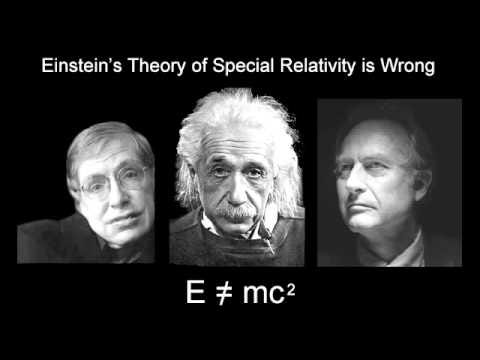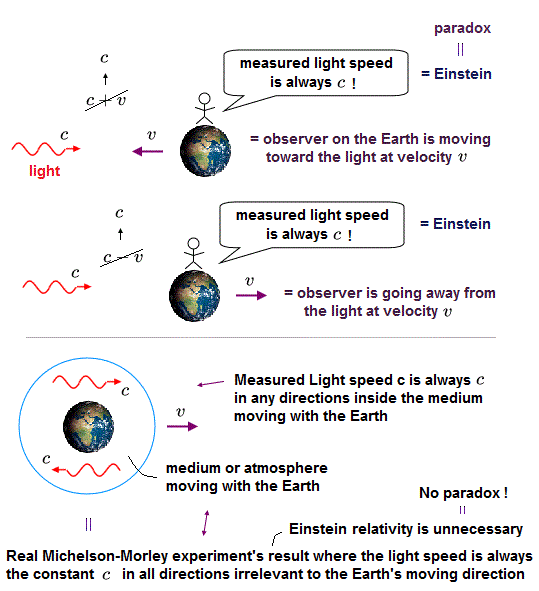Saturday, March 30, 2024
Einstein and his Ether. Refuting his own theories of Relativity and make-believe.
Not the 'greatest scientist ever' but a desperate mathematician trying to prove Copernicanism and the self-created Universe.
by StFerdIII
Prologue
It was known 100 years ago that the 1905 Special Theory of Relativity or STR was wrong. Many contemporaries of Einstein eviscerated his make-believe world of flux and change, a universe with no fixed absolutes in which reality itself was optional, subject to endless unproven ‘dimensions’, untestable but necessary to support Copernicanism and the Big Bang. Einstein admits that his theory of Special Relativity is bunk by creating his General Theory of Relativity (1915-19), which included the ‘ether’, a ‘medium’ identifying absolute space, which he absolutely detested pre-1905. The insertion of an ether in his GTR is more than enough to kill off STR. If STR is bunk, then the Big Bang theory is also junk and invalidated. Copernicanism remains just a theory, still unproven regardless of confident expostulations and online apologia to the contrary.
As many other posts have detailed if there is an ether, or if the speed of light is inconstant or not confined to 186.000 miles per second velocity, or is impacted by the medium not the velocity of the ‘observer’, then STR is destroyed. Indeed, all these suppositions are true. Since STR is just a mathematical concept and lies at the heart of both heliocentricity and Big Bang theology, they too must be jettisoned or at the very least, be coerced to provide some real tangible evidence for their claims.
Greatest Scientist evah….
In 1905, in his STR paper, ‘the greatest scientist in world history’ declared:
“The introduction of a ‘light ether’ will prove to be superfluous, because the view here to be developed will introduce neither a ‘space at absolute rest’ provided with special properties, nor assign a velocity vector to a point of empty space in which electro-magnetic processes take place.” (Einstein, 17, Sept. 26, 1905).
As this post and the next will outline, space is not empty. What Einstein was really attempting to do was refute the Fizeau (1851) and Michelson experiments (1881, 1887) which had inadvertently disproved heliocentricity and Earth mobility, as well as diurnal rotation. To do this, he needed to remove all absolutes from ‘The Science’. The absolutes of space and time were for Einstein, the core reasons why Earthly mobility was not measurable.
As a diehard Copernican faithful, Einstein’s religious-philosophical outlook was paramount in his abstract mental experiments. Only Relativity could explain why we can’t measure the Earth’s 108.000 km per hour trot around the Sun, or why we can’t mechanically prove the Earth’s rotation. No absolutes were to be allowed including space and rest (an example being the Earth’s immobility). All objects must be in relative motion in a ‘vacuum’ or ‘absolute’ nothingness. A vacuum does not mean an absence of material reality. It means the absolute nothingness of no material or physical reality.
Relativity and its pseudo-make-believe world of maths and theories would therefore come to the Copernican rescue and save ‘The Science’. But it was mandatory for Einstein that no absolute ether was to be allowed. Ether or the medium of space, was however central to Maxwell, Lorentz and Poincare’s mathematics and theorems and an indispensable foundation for electromagnetic theory and physics.
Einstein consumed and reused Maxwell and Lorentz’s maths almost in toto within his STR and GTR frameworks, without bothering to reference his debt to their theories or affirming his reuse of their hard work. His disciples and cheerleaders praise this lack of referencing as ‘saving time’ because the annotations are ‘so obvious’. Or maybe it simply denotes laziness, a capacity to mislead and hints of fraud. Such attitudes and actions were typical of Einstein as they were with Galileo.
Big Al recants
Eleven years later in 1916, the acclaimed ‘greatest scientist in history’ wrote:
…in 1905 I was of the opinion that it was no longer allowed to speak about the ether in physics. This opinion, however, was too radical, as we will see later when we discuss the general theory of relativity. It does remain allowed, as always, to introduce a medium filling all space and to assume that the electromagnetic fields (and matter as well) are its states…once again “empty” space appears as endowed with physical properties, i.e., no longer as physically empty, as seemed to be the case according to special relativity. One can thus say that the ether is resurrected in the general theory of relativity….Since in the new theory, metric facts can no longer be separated from “true” physical facts, the concepts of “space” and “ether” merge together. (Einstein, “cited in Kostro, p. 2).
So, in 11 years, the ‘greatest scientist who ever existed’, the massive brain which overshadows all others, completely overturns his own personal theory and the attempt to save Copernicanism and embraces the ‘absolute’ reality that space is not a ‘vacuum’ and is not ‘nothing’. And how many people know this? The cheerleaders of ‘The Science’ praise this of course as ‘science correcting itself’. No. It has nothing to do with real science, but with trying to ‘save the phenomena’ of Copernicanism and its misanthropic ‘principle’.
The make-believe world of Special Relativity
As a committed Copernican Einstein was horrified by the litany of failed 19th century experiments which disproved the Earth’s orbit around the Sun, and its diurnal rotation (many posts on this substack outline these). Such redounding failures led Einstein and ‘The Science’ to believe that perhaps the ether had no effect on objects because, as these experiments had apparently proved, a light beam traveling with the Earth’s velocity of 30 km/sec against the ether (the purported speed of our planet as it races around the Sun), experienced no reduction in its speed when compared to a light beam that was not traveling against the ether.
Given that light speed seemed independent of an ether, perhaps it was possible to jettison the concept altogether? The underlying assumption for Einstein and ‘The Science’ was always that the Earth was mobile. The possibility of immobility was dismissed. This bias left only 2 suppositions for Einstein and ‘The Science’ when looking at the litany of failed 19th and 20th century experiments which could not prove the Earth’s mobility.
(a) that ether traveled with the Earth in its revolution around the Sun; or
(b) there is no ether, and light itself is an absolute
Einstein decided that the ‘ether train’ around the Earth, dragged by the Earth in its sprint around the Sun, could not exist. It would be too close to Newton’s ‘absolute space’. He therefore plumped for option b, that there is no ether, and the speed of light is an absolute.
Einstein could now rewrite physics and history. He could reference the failed heliocentric experiments from Arago and Fizeau, to Michelson and Sagnac, as supportive of his Relativity theory, based as it was on the constant speed of light and ignore that these experiments did not prove the constancy of light speed (Sagnac proved that light was inconstant) and ignore that they disproved Earth mobility.
Very convenient. More here

